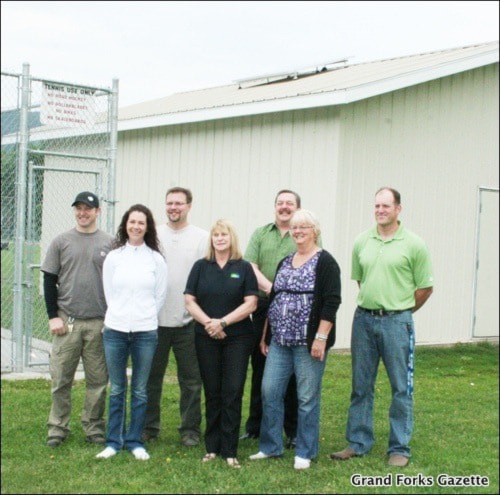With Grand Forks declared a solar community by SolarBC last year, it's fitting that its high school is now partially powered by solar energy.
The athletic storage fieldhouse behind the tennis courts at Grand Forks Secondary School (GFSS) had solar paneling installed and it will help provide energy to the building.
“There are two 185-watt panels running down to a charge controller, which charges two 120-amp power AGM (absorbed glass mat) batteries and a little micro inverter that converts to 120-volts so they can plug in pumps for their soccer balls and stuff like that,” explained Greg Vanderzande, part owner of Cascade Electric, the company that installed the solar panels along with Okanagan Solar out of Kelowna.
“It’s just a basic stand-alone system, it’s not tied into the grid or anything and it runs four LED lights in there just so that they can get in there when it’s dark.”
Vanderzande said that while it depends on sunlight and how drawn down the batteries are, it takes about two days to charge the batteries and how long it lasts depends on what is being plugged in.
“Those are 120-amp hour batteries so you have 240-amp hours at 12 volts, so you can draw 240-amps for one hour on that system but that’s at 100 per cent discharge, you only want to really bring the batteries down to 60 or 50 per cent.”
Jessie McGraw, an educational assistant from Boundary Central Secondary School, was the one who spearheaded the project and although some of the funding fell through, she said that it was done thanks to financial aid from a number of different sources.
“We had applied for a grant through SolarBC and unfortunately we weren’t successful in that,” explained McGraw.
“There were 50 schools that applied and 11 got it but our wonderful funders, the City of Grand Forks, the Grand Forks Credit Union and Areas C and D of the regional district (RDKB), had sent their contributions in already in hopes of a successful grant application and so this project came up and I approached the funders asking if it would be alright if that money was used on (the fieldhouse).”
McGraw says they agreed and now GFSS has a stand-alone solar building.
RDKB Area C Director Grace McGregor and Area D Director Irene Perepolkin both agreed it was a good way to spend their grant-in-aid money, especially seeing as some of the community’s future leaders are at GFSS and it was good to have them thinking about different sources from which to draw power.
“They can actually go home and teach their parents the importance of alternative energy,” McGregor said.
“Quite frankly, if we don’t all start looking at alternative energy, we’re going to wish we had sooner or later – I think this is a positive approach within the community and it also teaches at the same time.”
For the credit union, it was a way to contribute to the community.
“The credit union tries to give where our members are interested in seeing changes and differences made in our community,” explained Angela Soukoreff, the credit union’s senior manager, marketing and communications.
“Certainly, solar power energy is something that is on many agendas and the topic of conversation these days and we were approached by our school district partners and asked if we could contribute primarily to leverage for a larger provincial grant and so we stepped up to the plate and we’re partners,” she went on to say.
While the solar panels are now in place, there could be more use for solar energy for the building, said McGraw.
“We’re sort of looking into seeing if (solar hot water) is a possibility – that would be just for running the sinks,” she went on to say.
